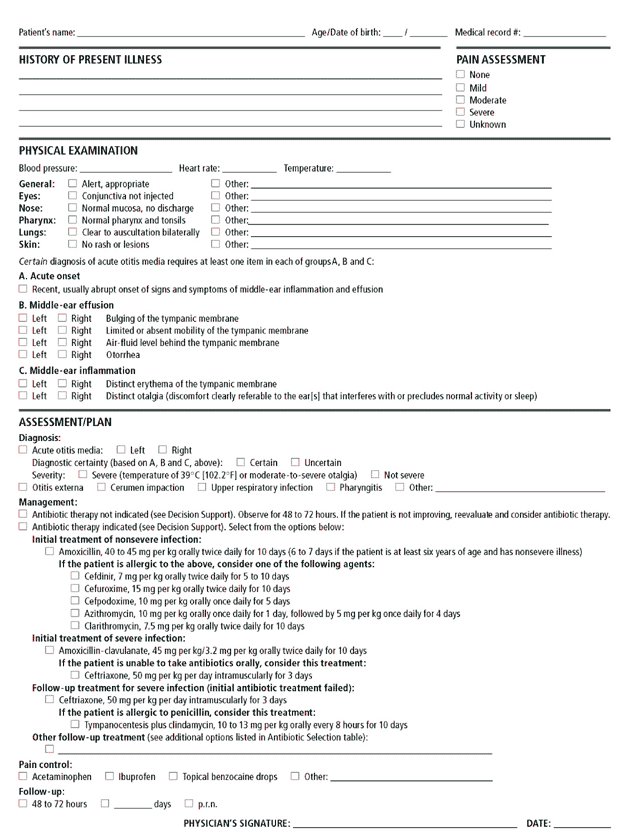
Am Fam Physician. 2004;69(12):2896-2898
Clinical Question
What is the best way to manage uncomplicated acute otitis media (AOM) in otherwise healthy children?
Evidence Summary
The American Academy of Pediatrics and the American Academy of Family Physicians recently released an evidence-based practice guideline to help physicians provide the most up-to-date care for children with AOM.1 The subcommittee that developed the guideline included primary care physicians, pediatricians, and experts in the fields of infectious disease, epidemiology, and otolaryngology. The subcommittee reviewed the best available evidence before making its recommendations. All recommendations have been substantiated by research evidence and have been assigned a rating for the strength of the evidence.
The guideline applies to otherwise healthy children between two months and 12 years of age with uncomplicated AOM. A specific definition of AOM is provided: “a diagnosis of acute otitis media requires a history of acute onset of signs and symptoms, the presence of middle-ear effusion, and signs and symptoms of middle ear inflammation.”1 Children suspected of having AOM who do not meet all three criteria are described as having an uncertain diagnosis of AOM. It also is important to distinguish AOM from otitis media with effusion, because only patients with AOM have the potential to benefit from antibiotics.
The guideline1 strongly recommends assessment of the child’s pain. Too often, an antibiotic is prescribed, but no recommendation for analgesia is provided. Use of acetaminophen or ibuprofen is recommended, although topical and naturopathic agents also have evidence of efficacy. The choice of analgesic should be based on an evaluation of risks and benefits, with consideration of the preference of the parent/caregiver and patient.
The decision to prescribe an antibiotic depends on the child’s age, the certainty of the diagnosis, and the severity of the symptoms. Severe AOM is characterized by severe otalgia and/or a temperature of at least 39°C (102.2°F). Observation without antibiotic therapy is an option in some children, provided that follow-up in 48 to 72 hours can be assured and analgesia is provided. Observation should be considered in children six months to two years of age with an uncertain diagnosis and nonsevere symptoms, children older than two years with a certain diagnosis but nonsevere symptoms, and children older than two years with an uncertain diagnosis. The guideline1 cites studies demonstrating that the majority of children improve within three days of presentation, even without antibiotics,2,3 and that the risk of complications is no higher when antibiotic therapy is delayed.4 If antibiotics are necessary for initial management, the recommended agents are amoxicillin (40 to 45 mg per kg orally twice daily) for children with nonsevere illness and amoxicillin-clavulanate (45 mg per kg/3.2 mg per kg orally twice daily) for children with severe symptoms or children in whom additional coverage for beta-lactamase–positive Haemophilus influenzae and Moraxella catarrhalis is desired.
The accompanying patient encounter form for children two months to 12 years of age who present with earache includes an assessment of pain, the definition of AOM, clinical decision support for the use of an antibiotic, guidance on selection of the most appropriate antibiotic, and a reminder to recommend analgesia.
Applying the Evidence
A two-year-old boy presents with one day of tugging at his right ear, a runny nose, and a temperature of 37.9°C (100.2°F). His appetite and fluid intake are good. Although the child is a bit irritable, he is not lethargic or toxic-appearing. On examination, the tympanic membrane is dull but not erythematous; the membrane has limited mobility. What is the diagnosis, and how should the patient be managed?
Answer: This patient has an uncertain diagnosis of AOM. Although there is evidence of effusion and an acute onset of symptoms, there is no evidence of inflammation. Furthermore, the illness is not severe (i.e., low-grade fever, nonspecific tugging at the right ear). It would be reasonable to provide analgesia in the form of acetaminophen and to have the parents observe the child carefully for 48 to 72 hours. If the child does not improve or shows signs of worsening, he should be reevaluated. If an antibiotic is required but symptoms are not severe, amoxicillin in a dosage of 45 mg per kg per day orally twice daily is the best choice if the patient is not allergic to penicillin.
